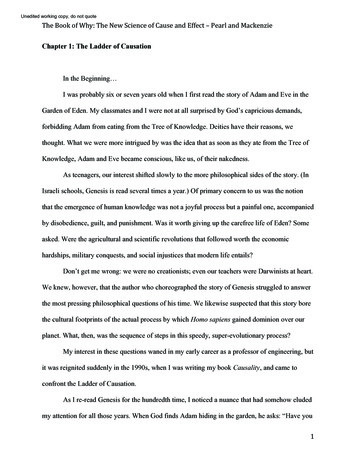
Transcription
Unedited working copy, do not PearlandMackenzieChapter 1: The Ladder of CausationIn the Beginning I was probably six or seven years old when I first read the story of Adam and Eve in theGarden of Eden. My classmates and I were not at all surprised by God’s capricious demands,forbidding Adam from eating from the Tree of Knowledge. Deities have their reasons, wethought. What we were more intrigued by was the idea that as soon as they ate from the Tree ofKnowledge, Adam and Eve became conscious, like us, of their nakedness.As teenagers, our interest shifted slowly to the more philosophical sides of the story. (InIsraeli schools, Genesis is read several times a year.) Of primary concern to us was the notionthat the emergence of human knowledge was not a joyful process but a painful one, accompaniedby disobedience, guilt, and punishment. Was it worth giving up the carefree life of Eden? Someasked. Were the agricultural and scientific revolutions that followed worth the economichardships, military conquests, and social injustices that modern life entails?Don’t get me wrong: we were no creationists; even our teachers were Darwinists at heart.We knew, however, that the author who choreographed the story of Genesis struggled to answerthe most pressing philosophical questions of his time. We likewise suspected that this story borethe cultural footprints of the actual process by which Homo sapiens gained dominion over ourplanet. What, then, was the sequence of steps in this speedy, super-evolutionary process?My interest in these questions waned in my early career as a professor of engineering, butit was reignited suddenly in the 1990s, when I was writing my book Causality, and came toconfront the Ladder of Causation.As I re-read Genesis for the hundredth time, I noticed a nuance that had somehow eludedmy attention for all those years. When God finds Adam hiding in the garden, he asks: “Have you1
andMackenzieeaten from the tree which I forbade you?” And Adam answers: The woman you gave me for acompanion, she gave me fruit from the tree and I ate. “What is this you have done?” God asksEve. She replies: The serpent deceived me, and I ate.As we know, this blame game did not work very well on the Almighty, who banishedboth of them from the garden. The interesting thing, though, is that God asked what and theyanswered why. God asked for the facts, and they replied with explanations. Moreover, both werethoroughly convinced that naming causes would somehow paint their actions in a different color.Where did they get this idea?For me, these nuances carried three profound messages. First, that very early in ourevolution, humans came to realize that the world is not made up only of dry facts (what we mightcall data today), but that these facts are glued together by an intricate web of cause-effectrelationships. Second, that causal explanations, not dry facts, make up the bulk of ourknowledge, and that satisfying our craving for explanation should be the cornerstone of machineintelligence. Finally, that our transition from processors of data to makers of explanations wasnot gradual—it required an external push from an uncommon fruit. This matched perfectly whatI observed theoretically in the Ladder of Causation: no machine can derive explanations fromraw data. It needs a push.If we seek confirmation of these messages from evolutionary science, we of course won’tfind the Tree of Knowledge, but we still see a major unexplained transition. We understand nowthat humans evolved from ape-like ancestors over a period of 5-6 million years, and that suchgradual evolutionary processes are not uncommon to life on Earth. But in roughly the last 50,000years, something unique happened, which some call the Cognitive Revolution and others (with atouch of irony) call the Great Leap Forward. Humans acquired the ability to modify theirenvironment and their own abilities at a dramatically faster rate.2
andMackenzieFor example, over millions of years, eagles and owls have evolved truly amazingeyesight—yet they never evolved eyeglasses, microscopes, telescopes, or night-vision goggles.Humans have produced these miracles in a matter of centuries. I call this phenomenon the“super-evolutionary speedup.” Some readers might object to my comparing apples and oranges,evolution to engineering, but that is exactly my point. Evolution has endowed us with the abilityto engineer our lives, a gift she has not bestowed upon eagles and owls, and the question is again,Why? What computational facility did humans suddenly acquire that eagles lacked?Many theories have been proposed, but there is one I like because it is especiallypertinent to the idea of causation. In his book Sapiens, historian Yuval Harari posits that ourancestors’ capacity to imagine non-existent things was the key to everything, for it allowed themto communicate better. Before this change, they could only trust people from their immediatefamily or tribe. Afterward their trust extended to larger communities, bound by common beliefsand common expectations (for example, beliefs in invisible yet imaginable deities, in theafterlife, and in the divinity of the leader). Whether you agree with Harari’s theory or not, theconnection between imagining and causal relations is almost self-evident. It is useless to knowthe causes of things unless you can imagine their consequences. Conversely, you cannot claimthat Eve caused you to eat from the tree unless you can imagine a world in which, counter tofacts, she did not hand you the apple.Back to our H. sapiens ancestors: their newly acquired causal imagination enabled themto do many things more efficiently, through a tricky process we call “planning.” Imagine a tribepreparing for a mammoth hunt. What would it take for them to succeed? My mammoth-huntingskills are rusty, I must admit, but as a student of thinking machines I have learned one thing. Theonly way a thinking entity (computer, caveman, or professor) can accomplish a task of suchmagnitude is to plan things in advance. To decide how many hunters to recruit; to gauge, given3
andMackenziethe wind conditions, what direction to approach the mammoth; and more. In short, to imagineand compare the consequences of several hunting strategies. To do this, it must possess, consult,and manipulate a mental model of its reality.Here is how we might draw such a mental model:Figure 1. Perceived causes of a successful mammoth hunt.Each dot in the diagram represents a cause of success. Note that there are multiple causes,and that none of them are deterministic. That is, we cannot be sure that more hunters will enableus to succeed, or that rain will prevent us from succeeding; but these factors do change ourprobability of success.The mental model is the arena where imagination takes place. It enables us to experimentwith different scenarios, by making local alterations to the model. Somewhere in our hunters’mental model was a subroutine that evaluated the effect of the number of hunters. When theyconsidered adding more, they didn’t have to evaluate every other factor from scratch. They couldmake a local change to the model, replacing “Hunters 8” by “Hunters 9” and re-evaluatingthe probability of success. This modularity is a key feature of causal models. .I don’t mean to imply, of course, that early humans actually drew a pictorial model likethis one. Of course not! But when we seek to emulate human thought on a computer, or indeedwhen we try to solve unfamiliar scientific problems, drawing an explicit dots-and-arrows picture4
andMackenzieis extremely useful. You will see many in this book, and I will call them causal diagrams. Theyare the computational core of the “causal inference engine” described in Chapter 1.The Three Levels of CausationSo far I may have given the impression that the ability to organize our knowledge of theworld into causes and effects was monolithic and acquired all at once. But in fact, my researchon machine learning has taught me that there are at least three distinct levels that need to beconquered by a causal learner: seeing, doing, and imagining.The first cognitive ability, seeing or observation, is the detection of regularities in ourenvironment, and it is shared by many animals as well as early humans before the CognitiveRevolution. The second ability, doing, stands for predicting the effect(s) of deliberate alterationsof the environment, and choosing among these alterations to produce a desired outcome. Only asmall handful of species have demonstrated elements of this skill. Usage of tools, provided theyare designed for a purpose and not just picked up by accident or copied from one’s ancestors,could be taken as a sign of reaching this second level. Yet even tool users do not necessarilypossess a “theory” of their tool that tells them why their tool works and what to do when itdoesn’t. For that, you need to be at a level of understanding that permits imagining. It wasprimarily this third level that prepared us for further revolutions in agriculture and science, andled to a sudden and drastic change in our species’ impact on planet Earth.I cannot prove this, but what I can prove mathematically is that the three levels arefundamentally different, each unleashing capabilities that the ones below it do not. Theframework I will use to show this goes back to Alan Turing, the pioneer of research in artificialintelligence, who proposed to classify a cognitive system in terms of the queries it can answer.5
andMackenzie6
andMackenzieFigure 2. The Ladder of Causation, with representative organisms at each level. Most animals aswell as present-day learning machines are on the first rung, learning from association. Toolusers, such as early humans, are on the second rung, if they act by planning and not merely byimitation. We can also use experiments to learn the effects of interventions, and presumably thisis how babies acquire much of their causal knowledge. On the top rung, counterfactual learnerscan imagine worlds that do not exist and infer reasons for observed phenomena.7
andMackenzieThis is an exceptionally fruitful approach when we are talking about causality, because itbypasses long and unproductive discussions of “What is causality exactly?” and focuses insteadon the concrete and answerable question, “What can a causal reasoner do?” Or more precisely,what can an organism possessing a causal model compute that one lacking such a model cannot?While Turing was looking for a binary classification—human or non-human—ours has threetiers, corresponding to progressively more powerful causal queries. Using these criteria, we canassemble the three levels of queries into one Ladder of Causation (Figure 2), a metaphor that wewill return to again and again.Let’s take some time to consider each rung of the ladder in detail. At the first level,Association, we are looking for regularities in observations. This is what an owl does when itobserves how a rat moves and figures out where it is likely to be a moment later, and it is what acomputer go program does when it studies a database of millions of go games so that it canfigure out which moves are associated with a higher percentage of wins. We say that one event isassociated with another if observing one changes the likelihood of observing the other.The first rung of the ladder calls for predictions based on passive observations. It ischaracterized by the question: “What if we see [X]?” For instance, imagine a marketing directorat a department store, who asks, “How likely is it that a customer who bought toothpaste willalso buy dental floss?” Such questions are the bread and butter of statistics, and they areanswered, first and foremost, by collecting and analyzing data. In our case, the question can beanswered by first taking the data consisting of the shopping behavior of all customers, selectingonly those who bought toothpaste, and, focusing on the latter group, computing the proportionwho also bought dental floss. This proportion, also known as a “conditional probability,”measures (for large data) the degree of association between “buying toothpaste” and “buying8
andMackenziefloss.” Symbolically, we can write it as P(Floss Toothpaste). The “P” stands for “probability,”and the vertical line means, “given that you see.”Statisticians have developed many elaborate methods to reduce a large body of data andidentify associations between variables. A typical measure of association, which we will mentionoften in this book, is called “correlation” or “regression,” which involves fitting a line to acollection of data points and taking the slope of that line. Some associations might have obviouscausal interpretations. Other associations may not. But statistics alone cannot tell which is thecause and which is the effect, toothpaste or floss. From the point of view of the sales manager, itmay not really matter. Good predictions need not have good explanations. The owl can be a goodhunter without understanding why the rat always goes from point A to point B.Some readers may be surprised to see that I have placed present-day learning machinessquarely on rung one of the Ladder of Causation, sharing their wisdom with an owl. We hearalmost every day, it seems, about rapid advances in machine learning systems—self-driving cars,speech-understanding systems, and especially in recent years, deep-learning algorithms (or deepneural networks). How could it be that they are still only at level one?The successes of deep learning have been truly remarkable, and have caught many of usby surprise. Nevertheless, deep learning has succeeded primarily by showing that certainquestions or tasks we thought were difficult are in fact not so difficult. It has not addressed thetruly difficult questions that continue to prevent us from achieving human-like AI. The result isthat the public believes that “strong AI,” machines that think like humans, is just around thecorner or maybe even here already. In reality, nothing could be farther from the truth. I fullyagree with Gary Marcus, a neuroscientist at New York University, who recently wrote in theNew York Times that the field of artificial intelligence is “bursting with microdiscoveries”—thesort of things that make good press releases—but that machines are still disappointingly far from9
andMackenziehuman-like cognition. My colleague in computer science at UCLA, Adnan Darwiche, has just (asof July 2017) written a position paper called “Human-Level Intelligence or Animal-LikeAbilities?” which I think frames the question in just the right way. The goal of strong AI is toproduce machines with human-like intelligence, able to converse with humans and guide us.What we have gotten from deep learning instead is machines with abilities—truly impressiveabilities—but no intelligence. The difference is profound, and lies in the absence of a model ofreality.Just as they did 30 years ago, machine-learning programs (including those with deepneural networks) operate almost entirely in an associational mode. They are driven by a streamof observations to which they attempt to fit a function, in much the same way that a statisticiantries to fit a line to a collection of points. Deep neural networks have added many more layers tothe complexity of the fitted function but still, what drives the fitting process is raw data. Theycontinue to improve in accuracy as more data are fitted, but they do not benefit from the “superevolutionary speedup” that we encountered above. They end up with a brittle, special-purposesystem that is inscrutable even to its programmers. The architects of a program like AlphaGo(which recently defeated the best human go players) do not really know why it works, only that itdoes. The lack of flexibility, adaptability, and transparency is not in the least bit surprising; it isinevitable in any system that works at the first level of the Ladder of Causation.We step up to the next level of causal queries when we begin to change the world. Atypical question for this level is, “What will happen to our floss sales if we double the price oftoothpaste?” This already calls for a new kind of knowledge, absent from the data, which we findat rung two of the Ladder of Causation, Intervention.Intervention ranks higher than Association because it involves not just seeing what is, butchanging what is. Seeing smoke tells us a totally different story about the likelihood of fire than10
andMackenziemaking smoke. Questions about interventions cannot be answered by using passively collecteddata, no matter how big the data or how deep your neural network. It has been quite traumatic formany scientists to learn that none of the methods they learn in statistics are sufficient even toarticulate, let alone answer, a simple question like, “What happens if we double the price?” Iknow this because I have had many occasions to help them climb to the next rung of the ladder.Why can’t we answer our floss question just by observation? Why not just go into ourvast database of previous purchases and see what happened previously when toothpaste costtwice as much? The reason is that on the previous occasions, the price may have been higher fordifferent reasons. For example, the product may have been in short supply, and every other storealso had to raise its price. But now you are considering a deliberate intervention that will set anew price regardless of market conditions. The result might be quite different from what it waswhen the customer couldn’t find a better deal anywhere else. If you had data on the marketconditions that existed on the previous occasions, perhaps you could figure it out but what datado you need? And then, how would you figure it out? Those are exactly the questions the scienceof causal inference allows us to answer.One very direct way to predict the result of an intervention is to experiment with it undercarefully controlled conditions. Big Data companies like Facebook know this, and theyconstantly perform experiments to see what happens if items on the screen are arrangeddifferently, or if the customer is given a different prompt (or even a different price).What is more interesting, and less widely known—even in Silicon Valley—is thatsuccessful predictions of the effects of interventions can sometimes be made even without anexperiment. For example, the sales manager could develop a model of consumer behavior thatincludes market conditions. Even if she doesn’t have data on every factor, she might have dataon enough key surrogates to make the prediction. A sufficiently strong and accurate causal11
andMackenziemodel can allow us to use rung-one (observational) data to answer rung-two (interventional)queries. Without the causal model, we could not go from rung one to rung two. This is whydeep-learning systems (as long as they use only rung-one data and do not have a causal model)will never be able to answer questions about interventions, which by definition break the rules ofthe environment the machine was trained in.As these examples illustrate, the defining query of the second rung of the Ladder ofCausation is, “What if we do?” What will happen if we change the environment? We can writethis kind of query as P(Floss do(Toothpaste)), the probability that we will sell floss at a certainprice, given that we set the price of toothpaste at another price.Another popular question at the second level of causation is “How?”, which is a cousin of“What if we do?” For instance, the manager may tell us that we have too much toothpaste in ourwarehouse. “How can we sell it?” he asks. That is, at what price should we set it? Again, thequestion refers to an intervention, which we want to perform mentally before we decide whetherand how to do it in real life. That requires a causal model.Interventions occur all the time in our daily lives, although we don’t usually use such afancy term for them. For example, when we take aspirin to cure a headache, we are interveningon one variable (the quantity of aspirin in our body) in order to affect another one (our headachestatus). If we are correct in our causal belief about aspirin, the “outcome” variable will respondby changing from “headache” to “no headache.”While reasoning about interventions is an important step on the causal ladder, it still doesnot answer all questions of interest. We often wish to ask: My headache is gone now, but why?Was it the aspirin I took? The food that I ate? The good news I heard? These queries take us tothe top rung of the Ladder of Causation, the level of Counterfactuals, because to answer them wemust go back in time, change history and ask, “What would have happened if I had not taken the12
andMackenzieaspirin?” No experiment in the world can deny treatment to an already treated person andcompare the two outcomes, so we must import a whole new kind of knowledge.Counterfactuals have a particularly problematic relationship with data because data are,by definition, facts. They cannot tell us what will happen in a counterfactual or imaginary world,in which some observed facts are bluntly negated. Yet the human mind does make suchexplanation-seeking inferences, reliably and repeatably. Eve did it when she identified “Theserpent deceived me” as the reason for her action. This is the ability that most distinguisheshuman from animal intelligence, as well as model-blind versions of AI and machine learning.You may be skeptical that science can make any useful statement about “would haves,”worlds that do not exist and things that have not happened. But it does, and it always has. Thelaws of physics, for example, can be interpreted as counterfactual assertions, such as: Had theweight on this spring doubled, its length would have doubled as well (Hooke’s Law). Thisstatement is, of course, backed by a wealth of experimental (rung-two) evidence, on hundreds ofsprings, in dozens of laboratories and on thousands of different occasions. However, onceanointed with the term “law,” physicists interpret it as a functional relationship that governs thisvery spring, at this very moment of time, under hypothetical values of the weight. All of thesedifferent worlds, where the weight is x pounds and the length of the spring is Lx inches, aretreated as being objectively knowable, and simultaneously active, even though only one of themactually exists.Going back to the toothpaste example, a top-rung question would be, “What is theprobability that a customer who bought toothpaste would still have bought it if we had doubledthe price?” We are comparing the real world (where we know that the customer bought thetoothpaste at the current price) to a fictitious world (where the price is twice as high).13
andMackenzieThe rewards of having a causal model that can answer counterfactual questions areimmense. Finding out why a blunder occurred allows us to take the right corrective measures inthe future. Finding out why a treatment worked on some people and not on others can lead to anew cure for a disease. Answering the question “What if things had been different?” allows us tolearn from history and from the experience of others, something that no other species appears todo. It is not surprising that the ancient Greek philosopher Democritus (460-370 BC) said, “Iwould rather discover one cause than be the King of Persia.”The position of counterfactuals at the top of the Ladder of Causation explains why I placesuch emphasis on them as a key moment in the evolution of human consciousness. I totally agreewith Yuval Harari that the depiction of imaginary creatures was a manifestation of a new ability,which he calls the cognitive revolution. His prototypical example is the Lion Man sculpture,found in Stadel Cave in southwestern Germany and now held at the Ulm Museum (see Figure 3).The Lion Man, roughly 40 thousand years old, is a mammoth tusk that has been sculpted in theform of a chimera, half man and half lion.We do not know who sculpted the Lion Man or what its purpose was, but we do know itwas made by anatomically modern humans and that it represents a break with any art or craft thathad gone before. Previously, humans had fashioned tools and representational art, from beads toflutes to spear points to elegant carvings of horses and other animals. The Lion Man is different:a creature of pure imagination.As a manifestation of our newfound ability to imagine things that have never existed, theLion Man is the precursor to every philosophical theory, scientific discovery, and technologicalinnovation, from microscopes to airplanes to computers. Every one of these had to take shape insomeone’s imagination before it was realized in the physical world.14
andMackenzieFigure 3. The Lion Man of Stadel Cave. The earliest known representation of an imaginarycreature (half man and half lion), it is emblematic of a newly developed cognitive ability, theability to reason about counterfactuals.15
andMackenzieThis leap forward in cognitive ability was as profound and important to our species asany of the anatomical changes that made us human. Within 10,000 years after the Lion Man’screation, all other hominids (except for the very geographically isolated Flores hominids) hadbecome extinct. And humans have continued to change the natural world with incredible speed,using our imagination to survive, adapt, and ultimately take over. The advantage we gained fromimagining counterfactuals was the same then as it is today: flexibility, the ability to reflect onand improve upon past actions and, perhaps even more significant, our willingness to takeresponsibility for past and current actions.As shown in Figure 2, the characteristic queries for the third rung of the Ladder ofCausation are “What if I had done ?” and “Why?” Both of these involve comparing theobserved world to a counterfactual world. Such questions cannot be answered by experimentsalone. While rung one deals with the seen world, and rung two deals with a brave new world thatis seeable, rung three deals with a world that cannot be seen (because it contradicts what is seen).To bridge the gap, we need a model of the underlying causal process, sometimes called a“theory” or even (in cases where we are extraordinarily confident) a “law of nature.” In short, weneed understanding.This is, of course, one of the holy grails of any branch of science—thedevelopment of a theory that will enable us to predict what will happen in situations we have noteven envisioned yet. But it goes even further: having such laws permits us to violate themselectively, so as to create worlds that contradict ours. Our next section will feature suchviolations in action.The Mini-Turing Test16
andMackenzieIn 1950, Alan Turing asked what it would mean for a computer to think like a human. Hesuggested a practical test, which he called “the imitation game,” but every AI researcher sincethen has called it the “Turing test.” For all practical purposes, a computer could be called athinking machine if an ordinary human, communicating with the computer by typewriter, wouldnot be able to tell whether he was talking with a human or a computer. Turing was veryconfident that this was within the realm of feasibility. “I believe that in about fifty years’ time itwill be possible to program computers,” he wrote, “ to make them play the imitation game sowell that an average interrogator will not have more than a 70 percent chance of making the rightidentification after five minutes of questioning.”Turing’s prediction was slightly off. Every year the Loebner Prize competition identifiesthe most human-like “chatbot” in the world, with a gold medal and 100,000 offered to anyprogram that succeeds in fooling all four judges into thinking that it is human. As of 2015, in 25years of competition, not a single program has fooled all the judges or even half of them.Turing didn’t just suggest the “imitation game,” he also proposed a strategy to pass it.“Instead of trying to produce a program to simulate the adult mind, why not rather try to produceone which simulates the child’s?” he asked. If you could do that, then you could just teach it thesame way you would teach a child and presto, twenty years later (or less, given a computer’sgreater speed), you would have an artificial intelligence. “Presumably the child brain issomething like a notebook as one buys it from the stationer’s,” he wrote. “Rather littlemechanism, and lots of blank sheets.” He was wrong about that: the child’s brain is rich inmechanisms and pre-stored templates.Nonetheless, I think that Turing’s instinct had more than a kernel of truth. We probablywill not succeed in creating human-like intelligence until we can create child-like intelligence,and a key component in this intelligence is the mastery of causation.17
andMackenzieHow can machines acquire causal knowledge? That is still a major challenge whichundoubtedly will involve an intricate combination of inputs from active experimentation, passiveobservation, and (not least) input from the programmer—much the same inpu
In his book Sapiens, historian Yuval Harari posits that our ancestors’ capacity to imagine non-existent things was the key to everything, for it allowed them to communicate better. Before this change, they could only trust people from their immediate family or tribe. Afterward their trus











